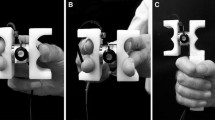Summary
A small object was gripped between the tips of the index finger and thumb and held stationary in space. Its weight and surface structure could be changed between consecutive lifting trials, without changing its visual appearance. The grip force and the vertical lifting force acting on the object, as well as the vertical position of the object were continuously recorded. Likewise, the minimal grip force necessary to prevent slipping, was measured. The difference between this minimal force and the employed grip force, was defined as the safety margin to prevent slipping.
It was found that the applied grip force was critically balanced to optimize the motor behaviour so that slipping between the skin and the gripped object did not occur and the grip force did not reach exeedingly high values. To achieve this motor control, the nervous system relied on a mechanism that measured the frictional condition between the surface structure of the object and the fingers. Experiments with local anaesthesia indicated that this mechanism used information from receptors in the fingers, most likely skin mechanoreceptors. In addition to friction, the control of the grip force was heavily influenced by the weight of the object and by a safety margin factor related to the individual subject. The frictional conditions during the previous trial could also, to some extent, influence the grip force.
Similar content being viewed by others
References
Bowden, FP, Tabor D (1973) Friction — an introduction to tribology. Anchor Press, Garden City, NY
Comaish S, Bottoms E (1971) The skin and friction: deviations from Amonton's law, and the effects of hydration and lubrication. Br J Dermatol 84: 37–43
Garnett R, Stephens JA (1981) Changes in the recruitment threshold of motor units produced by cutaneous stimulation in man. J Physiol (Lond) 311: 463–473
Granit R (1972) Constant errors in the execution and appreciation of movement. Brain 95: 649–660
Johansson RS, Vallbo ÅB (1983) Tactile sensory coding in the glabrous skin of the human hand. Trends Neurosci 6: 27–31
Johansson RS, Westling G (1981) Coordination between grip force and vertical lifting force when lifting objects between index finger and thumb. Soc Neurosci Abstr 7: 247
Kuypers HGJM (1981) Anatomy of the descending pathways. In: Brooks VB (ed) Handbook of physiology, sect 1, vol II. Am Physiol Soc, Bethesda, MD, pp 597–666
Lawrence DG, Kuypers HGJM (1968) The functional organization of the motor system in the monkey. I. The effects of bilateral pyramidal lesions. Brain 91: 1–14
Lemon RN (1981) Functional properties of monkey motor cortex neurones receiving afferent input from the hand and fingers. J Physiol (Lond) 311: 497–311
Marsden CD, Merton PA, Morton HB (1977) The sensory mechanism of servoaction in human muscle. J Physiol (Lond) 265: 521–535
McCloskey DI, Gandevia SG (1978) Role of skin, joints and muscles and of corollary discharges, in human discrimination tasks. In: Gordon G (ed) Active touch. Pergamon Press, Oxford, pp 177–187
Napier JR (1956) The prehensile movements of the human hand. J Bone Jt Surg 38B: 902–913
Torebjörk HE, Hagbarth K-E, Eklund G (1978) Tonic finger flexion reflex induced by vibratory activation of digital mechanoreceptors. In: Gordon G (ed) Active touch. Pergamon Press, Oxford, pp 197–203
Vierck CJ (1978) Interpretations of the sensory and motor consequences of dorsal column lesions. In: Gordon G (ed) Active touch. Pergamon Press, Oxford, pp 139–159
Westling G, Johansson RS (1980) Factors setting the grip force when lifting an object with index and thumb. Neurosci Letters [Suppl] 5: 113
Wilkes GL, Windnauer H, Brown IA (1973) Structure-property relationships of skin. CRC Crit Rev Bioengin 1: 453–495
Author information
Authors and Affiliations
Rights and permissions
About this article
Cite this article
Westling, G., Johansson, R.S. Factors influencing the force control during precision grip. Exp Brain Res 53, 277–284 (1984). https://doi.org/10.1007/BF00238156
Received:
Issue Date:
DOI: https://doi.org/10.1007/BF00238156




